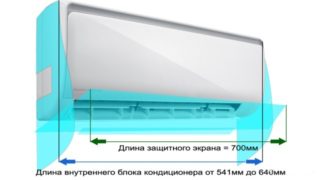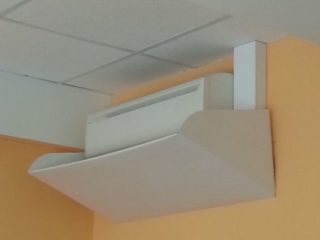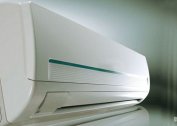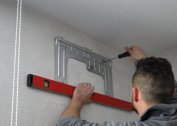The protective screen for the air conditioner is called differently: divider, deflector, reflector. The purpose of the device is to redirect the cold flow up. They invented it due to the fact that a sharp change in temperature on the street and in a chilled room leads to respiratory diseases. Especially susceptible to them are children in whom immunity has not yet been formed, and elderly people in whom the immune system can no longer cope with stress.
On the other hand, a powerful jet creates a kind of draft, which affects the state of the peripheral nervous system and with prolonged exposure can lead to pneumonia. Particularly relevant is the problem in office premises where employees are forced to stay at their workplace for a long time.
The principle of the reflector screen
 According to the laws of physics, warm air is lighter, so it’s located above. Cold tends down. All air conditioners operate on the principle of moving the chilled stream down to where people are. This creates health problems. If the flow is directed first up, then passing through a layer of warm air, it will cool it first, then, slightly heated, it will go down. Thus, it is possible to reduce the power of equipment and energy consumption, albeit slightly.
According to the laws of physics, warm air is lighter, so it’s located above. Cold tends down. All air conditioners operate on the principle of moving the chilled stream down to where people are. This creates health problems. If the flow is directed first up, then passing through a layer of warm air, it will cool it first, then, slightly heated, it will go down. Thus, it is possible to reduce the power of equipment and energy consumption, albeit slightly.
The reflector for the air conditioner is a panel of dense material that is installed on the route of the cold masses and redirects them up to the ceiling. The panel must be fixed securely to the walls or to the air conditioner itself. Depending on the selected material and its weight, simple screws or dowels are used.
At home, in the manufacture of a screen made of lightweight material, such as cardboard, you can do with double-sided construction tape. Heavier materials should not be attached to tape because they can fall off.
The industry offers several types of devices that differ:
- design
- configurations, depending on the type of air conditioner (wall, ceiling, cassette);
- materials.
The most commonly sold screens for wall-mounted household split systems. Based on the width of the indoor unit, a suitable divider is selected and mounted on the wall. In order for the split to work as usual, some rules must be observed during installation.
Types and types of protective screens for the air conditioner
The divider for the air conditioner is distinguished by the type of equipment installation:
- For wall system. The device is mounted on a wall.
- For ceiling air conditioner. Mounts are located on the ceiling or behind bars, and air flows diverge in different directions.
- For cassette centralized equipment.
- Mounted, which is attached to the air conditioner. This type is used for floor monoblocks.
By type of material:
- Plastic. Use transparent or opaque material. It does not always fit into the interior, but it’s easy to do it yourself, since the material is easy to bend. Attaching to a wall or ceiling will not be a problem.
- Cardboard. The lightest material - it bends easily, you can give it any shape. Not aesthetically pleasing, but the deflector will perform its functions. You can attach it with tape to the side walls of the air conditioner.
- Plexiglass is a type of plastic. Lightweight but requires gentle handling when bending. A building hairdryer is required to heat up.
- Acrylic.Most often used in the manufacture of protective screens for air conditioners of various types. You can choose by texture, color, thickness.
- Polycarbonate Transparent lightweight material, very durable (several hundred times stronger than glass), non-toxic.
- Metal. In the manufacture of screens using thin sheets. Valued for resistance to bending, if you want to make the design of the divider, in which there are side protective wings.
According to the design of the device:
- standard;
- rotary - with the possibility of air distribution in the vertical direction;
- with the possibility of direction in any direction horizontally.
Product price depends on:
- from the presence of airflow adjustment functions;
- from the material from which the device is made;
- from decorative qualities - with glued films, built-in diode lighting.
Some companies manufacture and install protective diffusers specifically for children's rooms with the appropriate design. Individual orders are calculated based on the complexity of work and installation.
Divider Installation Requirements
 In order for the air conditioner deflector to perform its functions well, you need to correctly calculate the length. It should be equal to the length of the indoor unit plus a couple of centimeters on the sides. Based on the weight of the product, reliable fasteners are selected. They are metal or plastic. Most often, plastic is used, since the device itself is made of plexiglass, acrylic or polycarbonate. Do not use tape if the screen is made of a material that is heavier than cardboard.
In order for the air conditioner deflector to perform its functions well, you need to correctly calculate the length. It should be equal to the length of the indoor unit plus a couple of centimeters on the sides. Based on the weight of the product, reliable fasteners are selected. They are metal or plastic. Most often, plastic is used, since the device itself is made of plexiglass, acrylic or polycarbonate. Do not use tape if the screen is made of a material that is heavier than cardboard.
It is recommended to position the structure 35 cm from the air conditioner in order to ensure a free exit and not interfere with the equipment. To direct the flow upward, the leading edge bends at an angle of 45 degrees. The depth of the deflector should be two times greater than the indoor unit to maximize the safety of people in the room.
How to make a screen for redirecting cold air
Of the tools for manufacturing at home, it may come in handy:
- screwdriver;
- ruler 1 m long;
- pencil or marker;
- screwdriver, drill for drilling holes;
- self-tapping screws from 3 to 6 pieces;
- scissors or knife;
- building hair dryer for heating plastic, plexiglass or acrylic;
- glass cutter, if the material for the screen is glass;
- building level.
Do-it-yourself plexiglass protective screen - work steps
Prepare a material whose width should equal the width of the air conditioner plus 15 - 20 cm of margin on the sides for organizing the wings. You can use plexiglass, the thickness of which is at least 3 mm, so that there are no vibrations from the outgoing air stream.
- Make a “pattern”. Mark 15 - 20 cm on each side and draw a line under the ruler. These are future side wings. They do not allow cold air to disperse throughout the room, so they are made quite high.
- On one side, measure 20 cm - this will be the mount. Mark the drilling points for the screws. Saw along the fold lines at the location of the intended wall mount.
- Bend the plexiglass along the lines, laying on the edge of the table along the proposed fold. Heat with a building hair dryer and gently bend down the sides to a 45 degree angle. The place of attachment to the wall is 90 degrees.
- Drill holes for self-tapping screws with a drill.
- Before mounting on the wall, it is advisable to know exactly where the wiring goes so as not to damage it. Attach the screen to the wall and mark the places for screws with a marker. To make installation strictly horizontally, use a building level. Drill holes in the wall and insert plastic dowels.
- Screw the shield to the wall with a screwdriver.
The ceiling deflector differs in the pattern and method of attachment. The dimensions of the air conditioner are marked on the pattern. Along the edges leave room for bends. For aesthetics, they should be the same width. Plexiglass is bent with a building hair dryer on four sides.There are two ways to fix the device:
- To the ceiling. To do this, use a bracket, one side of which is attached to the screen, the other to the ceiling.
- Brackets for the air conditioning grill. In this case, only one side of the bracket is screwed to the plexiglass. The second side is worn on the edge of the grill.
If there is an urgent need to organize a protective screen for a household split system, you can use thick cardboard and tape to connect to the body of the indoor unit. Such a structure does not look very presentable, but in the absence of materials and tools it saves people from colds in the hot season.
The pattern for the cardboard protective screen has higher side wings. They must be equal to the height of the indoor unit so that they can be glued with tape to the case. You need to bend them 90 degrees. For reliability, the front edge of the shield is also glued to the housing so that the fixture lasts longer.
To give a more aesthetic appearance, cardboard is painted in a suitable color or glued a film with a pattern on it.





